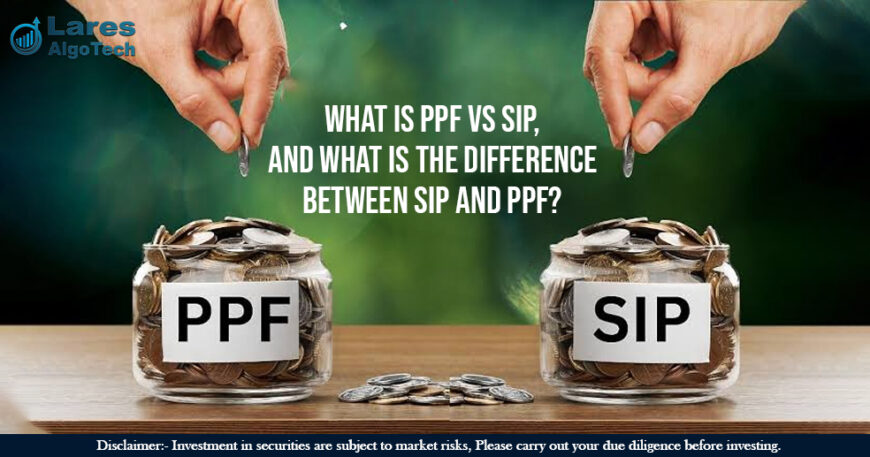When it comes to wealth creation and financial planning, investors in India often compare Public Provident Fund (PPF) with Systematic Investment Plan (SIP) in mutual funds. Both options have unique features, benefits, and risks. However, choosing between them depends on your financial goals, risk appetite, and investment horizon.
In this article, we at Lares Algotech will break down the concepts of PPF and SIP, their differences, advantages, and which one may be better suited for you in 2025 and beyond.
Understanding PPF (Public Provident Fund)
The Public Provident Fund (PPF) is a government-backed savings scheme introduced in 1968 to encourage long-term savings and provide safe returns. It is one of the most trusted investment avenues in India because it is backed by the sovereign guarantee of the Government of India.
Key Features of PPF
- Tenure: 15 years (extendable in blocks of 5 years).
- Minimum & Maximum Investment: ₹500 (minimum) to ₹1.5 lakh per year (maximum).
- Interest Rate: Announced quarterly by the government. (As of 2025, around 7.1% annually – subject to change).
- Tax Benefits: Contributions qualify for tax deduction under Section 80C of the Income Tax Act. Interest earned and maturity proceeds are completely tax-free (EEE status: Exempt-Exempt-Exempt).
- Risk Profile: Virtually risk-free since it is government guaranteed.
Pros of PPF
- Guaranteed, stable returns.
- Safe for risk-averse investors.
- Excellent long-term tax-saving instrument.
Cons of PPF
- Lock-in of 15 years reduces liquidity.
- Low flexibility in contribution amounts (annual maximum limit).
- Returns may not beat inflation significantly over long periods.
Understanding SIP (Systematic Investment Plan)
A Systematic Investment Plan (SIP) is a method of investing in mutual funds, particularly equity or debt schemes, where you invest a fixed amount at regular intervals (monthly, quarterly, etc.). It is designed to build disciplined investing habits while allowing you to benefit from the power of compounding and rupee cost averaging.
Key Features of SIP
Tenure: Flexible – you can invest for a few months or decades.
Minimum Investment: As low as ₹500 per month.
Returns: Market-linked, depending on the performance of the chosen mutual fund (equity, hybrid, or debt). Historically, equity SIPs have delivered 10–15% annualized returns over the long term.
Tax Benefits: Equity-linked SIPs (like ELSS funds) qualify for Section 80C deductions up to ₹1.5 lakh per year. However, capital gains are taxed depending on the holding period.
Risk Profile: Market-dependent; returns fluctuate with stock and bond performance.
Pros of SIP
- Flexible investment amount and tenure.
- Potential for higher returns compared to traditional savings schemes.
- Helps beat inflation over the long term.
- Compounding works strongly with long-term SIPs.
Cons of SIP
- Returns are not guaranteed.
- Requires patience to ride out market volatility.
- Exit loads and taxation apply in certain cases.
PPF vs SIP: A Side-by-Side Comparison
| Factor | PPF (Public Provident Fund) | SIP (Systematic Investment Plan) |
| Nature of Investment | Debt instrument, govt-backed | Market-linked (equity/debt funds) |
| Tenure/Lock-in | 15 years (extendable) | Flexible (no fixed lock-in except ELSS – 3 years) |
| Risk Level | Very Low (risk-free) | Moderate to High (depends on fund type) |
| Returns | 7–8% approx (fixed by govt) | 10–15% approx (market-dependent) |
| Liquidity | Limited (partial withdrawals after 7 years) | High (can redeem anytime, subject to exit load) |
| Tax Benefits | EEE (Tax-free at all stages) | ELSS under 80C; otherwise LTCG/STCG tax applies |
| Best For | Conservative, long-term savers | Growth-seeking, long-term investors |
Which is Better – PPF or SIP?
The answer depends on your financial goals
If Safety is Your Priority
PPF is a clear winner because it offers guaranteed returns and complete tax exemption. Retirees and conservative investors prefer PPF for this reason.
If Wealth Creation is the Goal
SIP is better as it can deliver higher inflation-adjusted returns over long horizons. Young professionals and investors with long investment timelines should prefer SIP.
Balanced Approach
Ideally, investors should diversify by investing in both – PPF for safety and SIPs for growth. This creates a balanced portfolio of debt and equity.
Case Study: PPF vs SIP Investment Over 15 Years
Let’s assume two individuals, Ravi and Anita, both investing ₹10,000 per month for 15 years.
Ravi invests in PPF at 7.1% interest rate:
Corpus after 15 years ≈ ₹32 lakh (tax-free).
Anita invests in SIP in an equity mutual fund with 12% average annual return:
Corpus after 15 years ≈ ₹50 lakh (before capital gains tax).
Clearly, SIP has the potential to generate higher wealth, but Ravi’s corpus is 100% risk-free. Anita bears market risk but earns higher inflation-beating returns.
How to Decide Between PPF and SIP?
When evaluating PPF vs SIP, consider these factors:
Risk Appetite
Are you comfortable with market fluctuations? If not, PPF is better.
Investment Horizon
Both work best in the long term. SIP needs at least 7–10 years to average out market volatility.
Liquidity Needs
If you need flexibility, SIP allows easy redemption, while PPF has strict withdrawal rules.
Tax Planning
Both help under Section 80C, but PPF gives tax-free maturity while SIPs are taxed on gains.
Inflation Adjustment
SIPs historically beat inflation, whereas PPF may not.
PPF vs SIP: The Future Outlook
As India’s economy grows and equity markets expand, SIPs are likely to continue offering attractive long-term returns. On the other hand, PPF will remain a safe haven investment, particularly for retirement planning and risk-free wealth accumulation.
With increasing awareness of financial planning in 2025, many investors are adopting a “Core + Satellite” strategy
- Core Portfolio: Safe instruments like PPF for stability.
- Satellite Portfolio: SIPs in equity mutual funds for aggressive growth.
This hybrid approach balances safety with wealth creation.
Final Thoughts
Both PPF and SIP play vital roles in a well-structured financial plan. PPF guarantees security and tax-free returns, making it ideal for conservative investors. SIPs, on the other hand, provide flexibility, inflation-beating returns, and wealth-building potential for those willing to embrace some risk.
At Lares Algotech, we believe that the right strategy isn’t choosing PPF vs SIP in isolation, but rather aligning both with your long-term financial goals. Whether you’re a salaried professional, a business owner, or a young investor starting your journey, combining PPF with SIP can give you the best of both worlds – safety plus growth.






 .facebook.com/lares.algotech
.facebook.com/lares.algotech  instagram.com/laresalgotech/
instagram.com/laresalgotech/  x.com/AlgoLares
x.com/AlgoLares  whatsapp.com/channel/...
whatsapp.com/channel/...  .linkedin.com/company/lares-algotech/
.linkedin.com/company/lares-algotech/  youtube.com/@LaresAlgoTech
youtube.com/@LaresAlgoTech